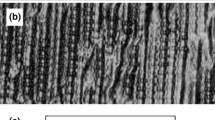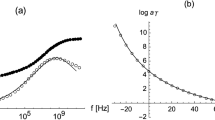Abstract
By rheology experiments we show that the torque created by sliding friction between a polyurethane foam planarizing pad and patterned silicon dioxide wafer in contact creates a large second-order tensile normal force previously found only in the torsion of bulk specimens. The normal force is a linear function of the square of the torque. Such tensile force reduces the applied compressive force. With elaborate polishing experiments we found second-order normal extension of the polymer into the valleys of the opposing surface which by interlocking the interface may provide a new mechanism for friction.
Similar content being viewed by others
References
A. D. Roberts, Rubber Chem. Tech. 65 (1992) 673.
D. J. Stein, D. L. Hetherington, D. B. James, K. Devriendt and K. Achutan, Proceedings of Sixth International Chemical-Mechanical Planarization for USLI Multilevel Interconnection (CMP-MIC), 453 (March 7–9, 2001, Santa Clara, CA, USA).
G. M. Bartenev and V. V. Lavrentev, Friction and Wear of Polymers (Elsevier, Amsterdam, 1981).
K. A. Grosch, Proc. Roy. Soc. London A 274 (1963) 21.
B. N. J. Persson, Surf. Sci. 401 (1998) 445.
A. M. Freudenthal and M. Ronay, Proc. Roy. Soc. A 292 (1966) 14.
B. Albrecht and A. M. Freudenthal, Int. J. Solids, Struct. 2 (1966) 555.
R. S. Rivlin, Phil. Trans. A 240 (1948) 459, 509.
R. S. Rivlin, Phil. Trans. A 241 (1948) 379.
R. S. Rivlin, J. Appl. Phys. 18 (1947) 444.
R. S. Rivlin and D. W. Saunders, Phil. Trans. A 243 (1951) 251.
B. D. Coleman, H. Markowitz and W. Noll, Viscometric Flows of Non-Newtonian Fluids (Springer, New York, 1966).
J. M. Steigerwald, S. P. Murarka and R. J. Gutman, Chemical Mechanical Planarization of Microelectronic Materials (John Wiley and Sons, New York, 1997).
C. L. Rohn, Analytical Polymer Rheology (Hanser Publishers, Munich, Vienna, New York, 1995), p. 81.
D. Ouma, B. Lee and D. Boning, Dielectric CMP characterization mask documentation. Version 1. 2 (characterization for STI). May 4, 1999. Microsystems Technology Laboratories, Massachusetts Institute of Technology, Cambridge, MA 02139.
D. Boning, Characterization methods and metrics for patterned wafer CMP. SEMI CMP Standards Meeting, SEMICON/WEST, July 1999, San Francisco, CA.
S. F. Soares, D. R. Baselt, J. P. Black, K. C. Jungling and W. K. Stowell, Appl. Opt. 33 (1994) 89.
B. Bhushan, in: Micro/Nanotribology and Its Applications, ed. B. Bhushan (Kluwer, Dordrecht, The Netherlands, 1997) p. 169.
M. Barquins, Wear 97 (1984) 111.
Author information
Authors and Affiliations
Corresponding author
Rights and permissions
About this article
Cite this article
Ronay, M., Rohn, C.L. Second-Order Normal Force and Extension Brought About by Sliding Friction of a Rubbery Polymer. Tribology Letters 14, 205–209 (2003). https://doi.org/10.1023/A:1022372515363
Issue Date:
DOI: https://doi.org/10.1023/A:1022372515363




